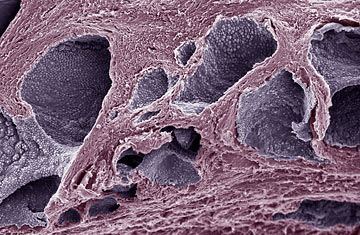
In the largest analysis of its kind, new research pinpoints how long older men who are diagnosed with early-stage prostate cancer can expect to live if they opt for a conservative, "watchful waiting" approach to their cancer treatment — as opposed to seeking immediate, aggressive therapies such as surgery and radiation.
Epidemiologists at the Cancer Institute of New Jersey examined national cancer-registry data involving 14,516 men over age 65 who were diagnosed with localized prostate cancer (that which has not spread beyond the prostate) from 1992 to 2002 and delayed surgery or radiation for at least six months after the diagnosis — the wait-and-see strategy commonly referred to as watchful waiting. In the majority of these patients — those who were diagnosed with early-stage disease at a median age of 78 — the 10-year risk of cancer-related death was less than 10%. Researchers also calculated the risk of death in a smaller group of watchful waiters who were diagnosed between ages 66 and 74, an age group for whom comparable data existed in past research. These patients' 10-year risk of death from prostate cancer was just 6% — a significant improvement over the risk in a similar group of men who were diagnosed from 1949 to 1992. Previous studies showed that their risk of death was as high as 15% to 23%.
That sharp improvement in mortality sounds hopeful, says Grace Lu-Yao, the lead author of the new study, which was published on Sept. 15 in the Journal of the American Medical Association, but it may be chalked up to a variety of factors, many of which have little to do with actual improvements in survival. For one: the classification of prostate-cancer stages has changed over the past 15 years. What might have been considered a Stage 3 or 4 cancer in 1990 would now be considered Stage 5, 6 or 7 — that is, a substantially more advanced cancer, says Lu-Yao. So it would stand to reason that men diagnosed with early-stage cancer today would survive longer than men diagnosed on the basis of yesterday's definition.
Another factor, says Lu-Yao, is the widespread use of the prostate-specific antigen (PSA) screen beginning in the 1990s. The controversial screen measures PSA levels in the blood to determine whether prostate cancer may be present. Since the screen can detect the tiny, early-stage cancers that in years past would have gone unnoticed, the number of patients diagnosed with (and cured of) prostate cancer in the modern era has gone up. Within the over-65 set in her study, Lu-Yao says, more patients were probably diagnosed with early-stage, survivable cancer compared with patients diagnosed from 1949 to 1992. So the PSA screen may have helped artificially boost survival rates of this group.
Still, the new findings confirm what oncologists have long known — that, in general, aggressive treatment for older prostate-cancer patients does not significantly improve survival. Indeed, according to the American Cancer Society (ACS), the 10-year survival rate for prostate-cancer patients over age 65 who pursue aggressive treatment (surgery, radiation or chemotherapy) is 97%, slightly higher than the survival rate of the 66-to-74-year-old patients in the current study who chose no treatment. "Cancer is the scariest word in medicine for many patients. The first thought is, Oh, my God, I'm going to die. The next thought is, What can we do to get rid of this? But we've known for quite some time that many men — especially those in their advanced age — don't need aggressive therapies," says Dr. Durado Brooks, director of prostate and colorectal cancers at the ACS.
But because doctors have been unable to inform men with any level of precision what their actual risk of death is from prostate cancer, fearful patients have often sought unnecessary surgery and radiation; fewer than 10% of patients who are diagnosed with prostate cancer at age 60 or older choose watchful waiting. "With this new evidence, doctors can give patients some quantifiable information so that together they can decide if it's more appropriate to forgo active treatment for now and just monitor their disease for any new developments," says Brooks, who was not involved in the study.
Many oncologists agree that older men — especially those over age 70 — are prime candidates for a watchful-waiting approach to treatment because prostate cancer is often a slow-growing disease that produces few or no symptoms and does not affect a man's quality of life after diagnosis. It is often referred to as a disease patients die with, rather than of. In Lu-Yao's study, men diagnosed with prostate cancer were up to five times more likely to die within 10 years from a non-prostate-related cause.
Still, prostate cancer remains the second most common cause of cancer death among men in the U.S., striking 1 in 6 men during their lifetime, according to the ACS. What researchers are now striving to determine — through new genetic technologies — is which cancers are aggressive and require invasive treatment, and which can be managed by waiting. Such advances could lead to not only true improvements in patient survival, but also major savings in health-care costs. "We are spending millions and millions of dollars on screening and treatment," says Lu-Yao. "It's not good for the individual, it's not good for our country as a whole, and we just can't afford to do it."
